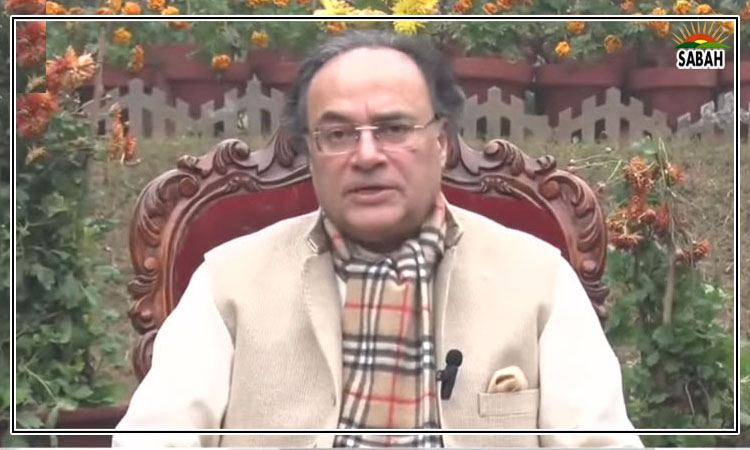Earth’s fever has hit new highs…Sameera Sheikh
According to the EU monitor, our planet is heating up at a pace that defies imagination, with 2023 temperatures eclipsing any period in the past 100,000 years.
This relentless rise can be traced back to the industrial juggernaut that began its course in Europe during the late 18th century. The legacy of fossil fuel-driven progress has spread like wildfire across the globe, creating an era of replication and expansion.
In the face of such dire prospects, the worlds leaders convened in 2015 at the UN Climate Change Conference, giving birth to the Paris Agreement, a beacon of hope aiming to restrain the increase in the global average temperature to well below 2 C above pre-industrial levels, while striving to limit the temperature increase to 1.5 C.
This agreement stands as a testament to the historical culpability of developed nations in the atmospheric accumulation of greenhouse gases. The Paris Agreement, a binding international accord on climate change, implores its signatories to submit Nationally Determined Contributions (NDCs) every five years, each time enhancing their climate action plans.
In this global narrative, Pakistan has played its part, submitting two sets of NDCs to the UNFCCC: the first in 2016, and a more ambitious one in 2021. The latter commits Pakistan to a 50 per cent reduction in greenhouse gas emissions by 2030, a monumental pledge with 15 per cent reliant on domestic resources and a staggering 35 per cent contingent on international financing.
These pledges place a heavy financial burden upon Pakistan, for transitioning to renewable sources of energy, the country needs $101 billion and, to put things in perspective, this figure was calculated in 2021 before the massive devaluation of the Pakistani rupee.
The finances needed to meet national commitments are colossal and, to say the least, so are the needs of the country to handle the adverse effects of climate change. Pakistan, persistently ranking among the top ten most climate-vulnerable countries, faces a barrage of extreme weather phenomena: searing heatwaves, tropical storms, unprecedented rainfall, and glacial lake outburst floods.
The pressing question looms: how can Pakistan finance the transformative measures necessary to combat the climate crisis? Many nations turn to carbon markets for a solution. The rationale is twofold: first, incentivization through carbon credits from reduction and removal projects, be it transitioning to e-mobility or expanding forests to absorb emissions. Second, cost efficiency in implementing NDCs, with studies suggesting carbon markets could slash costs by as much as 250 billion dollars by 2030.
The Paris Agreement endorses carbon markets through three mechanisms: a) utilization of Internationally Transferred Mitigation Outcomes (ITMOs) towards NDCs under Article 6.2; b) establishment of a mechanism to mitigate GHG emissions and support sustainable development under Article 6.4; and c) non-market approaches to assist NDC implementation.
In Pakistan, the Ministry of Climate Change & Environmental Coordination has drafted Carbon Market Policy Guidelines aimed at facilitating carbon trading, targeting a ceiling of 50 per cent or 280 MtCO2eq of the conditional target across sectors like transport, energy, and forestry. Provincial consent is pivotal as these projects span the country. However, provinces have voiced concerns over mandatory fees, particularly the Corresponding Adjustment Fee set at $4 per credit or 12 per cent of gross revenues, and the allocation of 10 per cent of credits for future NDC implementation.
The ministrys arguments for these fees are compelling: the need for Pakistan to elevate its mitigation targets and acquire carbon credits to curb emissions as economic growth accelerates and per capita emissions rise. The uniform fee structure is defended as necessary to fund adaptation and resilience activities in a country besieged by climate vulnerability. Provincial counterarguments are equally persuasive. High fees could deter investment in crucial sectors like industry and transport. They argue that fees should be reinvested by the Ministry based on provincial recommendations, ensuring local benefits.
A compromise is essential to resolve this standoff. Prolonged deadlock serves neither federal nor provincial interests, and the relentless march of climate change demands urgent, unified action.
Managing the unrelenting impacts of climate change must be the top priority and even the worst of differences must be set aside for the public good. To come to an agreement, the federal government can set the ball rolling by setting up institutional infrastructure for trading in carbon markets, that is establishing appropriate methodologies for quantifying mitigation outcomes, and setting up a national registry and greenhouse gas inventory for authorization and sale of credits.
Further, a Monitoring, Review and Valuation system may also be instituted by employing technologies like Artificial Intelligence for independently assessing the precision of reduction/removal of carbon emissions and ensuring environmental safeguards. To put it simply, participation in global climate markets is contingent upon capacity building, so the Ministry of Climate Change can initiate capacity-building activities for different stakeholders, especially at the level of districts.
Capacity-building programmes could empower district-level officials to manage carbon credit projects while protecting local communities. Provinces could also see their concerns addressed by lower corresponding adjustment fees for projects in highly degraded or vulnerable areas and a collaborative matrix for spending accrued fees on high-priority resilience and mitigation initiatives.
As global negotiations under Article 6 advance towards COP29, unresolved provincial reservations could thwart Pakistans ability to benefit from carbon offset projects and secure vital climate finance. The stakes are immense: failure to align could leave Pakistans populace, already on the climate crisis frontlines, without the means to develop locally suitable mitigation and adaptation strategies.
Courtesy The News












